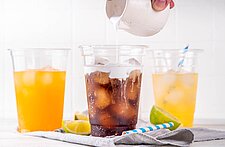The center of the supermarket represents a coming together of two worlds for shoppers: extreme convenience and extreme indulgence. Typically, this is where shoppers will spend the most time studying the shelves, but in the beginning of March, as reports on COVID-19 worsened and it became clear a nationwide lockdown was needed, shopping attitudes changed dramatically in just a week’s time.
Where the center of the store, specifically the in-between, indulgent food, perceived as “less healthy” than the fresher perimeter or of “less value” than frozen and nonperishable categories, lost out on most was the time consumers normally spend perusing aisles where they’re more likely to buy on whim and desire. Now, supermarkets limiting the number of people in the stores and the general fear of being out of the house in a contagious environment has cut shopping time to a fraction of what it was pre-COVID and put consumers on a mission to get in and get out with just the “essentials.”
Receive the latest trends and insights to your inbox, subscribe to the Weekly In-sight Newsletter!
Here we take a look at the new habits of shoppers as consumers wrestle with the need to buy necessities while fitting indulgence into their budgets.
MARCH SHOPPING SURGE
The first two weeks of March saw a huge spike in sales across every single category as panic buying and stockpiling happened, peaking on March 15 as stay-at-home orders came into effect, with home goods and non-edibles sales hitting a 110% change over the first week of January 2020, before dropping off drastically to 80% after March 15, according to IRi. After spiking mid-March and panic buying easing off, growth rates decelerated for non-foods; frozen, refrigerated, and alcohol categories surged; and fresh food sales remained high and steady.
However, even with an easing off of panic-buying, consumers are still buying more per trip and taking more trips – both stock up and small – to the supermarket than pre-COVID. According to the same report, mid-March spend for smaller trips grew 50% over the same time in 2019; pantry stocking trips grew 78 points from the previous year; and basket sizes were up 15% from last year with packaged food accounting for the greatest portion of growth in average basket size at 26%. According to a poll taken by IRi on March 13-15, 15% of survey respondents reported they’re purchasing more fresh foods, up 7 percentage points from a week prior while consumers stuck to the perimeter of the store where foods are perceived as “healthier” at the start and stockpiled non-edibles like toilet paper, cleaners, and paper towels.
 PROACTIVE VS. REACTIVE SHOPPERS
PROACTIVE VS. REACTIVE SHOPPERS
Before the nationwide closures, there were two sets of shoppers: the proactive and the reactive consumers. In February when reports were out about the growing concern of the virus, the proactive crowd, which skews younger and takes health and wellness into their own hands, were buying preventative products, like hand sanitizer, spray and bottled disinfectants, cleaning wipes, disposable gloves, bottled water, sore throat liquids, etc.
This was also the crowd who are single or with younger families stocking up on frozen, canned, and non-perishable foods early on, while also making sure they had plenty of indulgent “quarantine snacks” once the stay-at-home orders were issued. The reactive crowd, who skews older and more inclined to defer to doctors and pharmacists and not take a DIY approach to health, did not change their initial buying habits until after February. Even then, they are the group with older families who takes the most weekly stock up trips as this was previously part of their routine.
Related: Foodservice Adaptations in the Age of COVID-19
More than four in 10 Americans fall into the economic categories of “Cautious & Worried” or “Downtrodden,” a signal that we are entering a recession that will effect buying habits, said IRi. The Cautious crowd skews Baby Boomers whose financial situation is worse than average versus the same time last year and do not hold out hope for things to get better. The Downtrodden category skews older Millennials/Younger Boomers, blue collar workers, and minorities who also report a worse financial situation than the previous year and are cutting back on everything with purchases highly influenced by price and need. These are the groups most concerned about not affording groceries in the future, taking the most “stock up” trips, and buying the most fresh foods while avoiding the center of the store while their financial future remains uncertain.
FUTURE BUYING HABITS
As seen during 2007 to 2011, spending during and after a recession shows that consumers gravitate towards comfort and personal indulgence, a trend that will likely repeat throughout the COVID-19 crisis. Over the next month as shoppers settle into a new shopping routine and supermarket shelves have a chance to fully replenish after a period of panic purchasing, consumers will move out of “stock up” mode and get back to putting together shopping lists that look more like ones they made before the crisis. According to IRi, the average consumer keeps about two or more weeks of groceries on hand, about the time that fresh ingredients tend to spoil.
Lower income consumers will put their focus back on meal preparation as opposed to buying only pantry stock, but pull back on overall spending, so value brands and deals will be important while what’s deemed as high-priced, non-essentials will continue to be cut or bought at a lower volume. Middle- and upper-income consumers will venture back to picking up prepared foods and meal shortcuts for everyday meals while indulging in “non-essential,” comfort foods again. Comfort categories, like salty snacks, ice cream, cookies, and other “treats” will see an uptick overall as demonstrated by prior recessionary periods as people purchase value-priced foods that give them comfort or see as self-care in a time of high anxiety.
Continue reading the latest on COVID-19 and the food and beverage industry:
• Culinary Chronicles: Finding Comfort in Food During Turbulent Times
• Foodservice Adaptations in the Age of COVID-19
• Social Distancing Cuisine With Pantry Made Soup Recipes
• COVID-19's Impact on Alcoholic Beverage Categories
• Consumers 'Quarantine and Cook' With Social Media Inspiration






